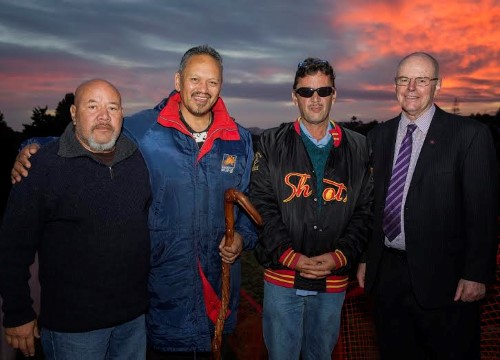$11M detention dam officially named, opened
9 Apr 2016, 2:25 PM
A multimillion dollar detention dam designed to better protect Whangarei’s Central Business District from damaging and costly floods has been officially named and opened.
The dam was blessed by local Whangarei kaumatua in a small dawn ceremony early today. A larger civic ceremony attended by about 60 people, including dignitaries, councillors and staff, tangata whenua, local residents and other members of the public, followed several hours later.
The latter ceremony saw the revelation of signage telling the story of the $11 million structure’s construction and displaying its formal name – ‘Hopua te Nihotetea’ – for the first time.
 Proud moment…Kaumatua Pari Walker, Daniel Hauraki and Fred Tito with regional council chairman Bill Shepherd, far right, as the sun rises during the dawn blessing ceremony for the new detention dam in Whangarei today. (Photo: Sue Shepherd).
Proud moment…Kaumatua Pari Walker, Daniel Hauraki and Fred Tito with regional council chairman Bill Shepherd, far right, as the sun rises during the dawn blessing ceremony for the new detention dam in Whangarei today. (Photo: Sue Shepherd).
Council chairman Bill Shepherd acknowledged the valuable contribution of local Te Parawhau hapu members during the dam’s construction and today’s blessing and importantly, for dedicating its appropriate official name.
“’Hopua te Nihotetea’ translates as ‘capturing the Nihotetea Stream’, which nicely reflects this detention dam’s purpose.” (Nihotetea Stream is a tributary at the headwaters of the Raumanga Stream.)
The dam is specifically engineered to rapidly capture up to 1.3 million cubic metres of floodwater during heavy rain – lessening the severity of major flooding from the Raumanaga Stream in the city’s CBD and parts of Morningside and Raumanga – and then slowly release it back into the Raumanga Stream over several days.
Councillor Shepherd says ultimately, the dam is expected to save about $1.4 million in damage annually over its extremely long operational life.
“Much of the the harm caused by floods depends not only on how deep they are, but crucially, how fast they’re travelling so the long-term financial benefits to our community from mitigating the worst of these factors can be quite substantial, especially when you consider this dam could be here for a century or longer.”
He says Hopua te Nihotetea isn’t designed to completely stop the CBD from flooding as the Waiarohia Stream and tidal Hatea River also flow into the area.
“What it will do in a very large storm is significantly slow damaging floodwaters and cut flood depths in the CBD by up to half a metre.”
Fellow regional councillor Craig Brown, who chairs the Urban Whangarei Rivers Liaison Committee, says the dam took about 16 months to build and is the largest project of its kind undertaken by the regional council.
“It really is a remarkable piece of engineering as a detention dam fills a very different purpose and behaves quite differently from storage dams most people will be more familiar with, like the Whau Valley dam, which provides much of urban Whangarei’s drinking water.”
Councillor Brown says for the vast majority of the time, Hopua te Nihotetea will actually hold no water at all and will really only come into its own when there’s a very large storm.
The dam is being paid for via a targeted rate on more than 17,000 properties in the Whangarei CBD and contributing catchment areas.
Webcams capturing images at the new dam can be viewed on the council’s website at: www.nrc.govt.nz/Environment/Webcams
